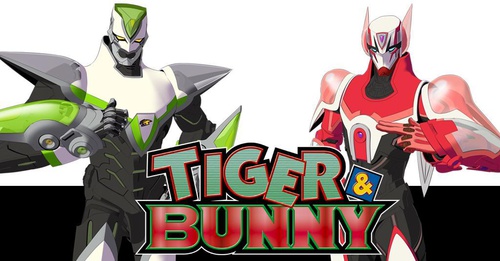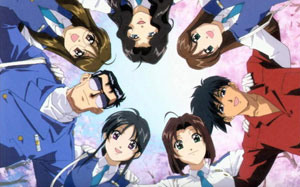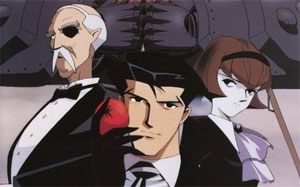If, Then, Or: Tiger & Bunny
by Gia Manry,If, Then, Or is a new biweekly column devoted to recommending anime titles— but with a bit of a twist. Every other Tuesday, I'll take a particular show and break it down into two major aspects, usually relating to genre, art style, characters, or themes. Then we offer up a recommendation for each of those aspects, giving you not one but two potential follow-up series based on which part of the original show you liked best. Let's go!
 Title: Tiger & Bunny Genre: Action Season: Spring 2011 Summary: The corporate-built city of Sternbild tries a unique take on crime control: they hire super-powered humans called NEXTs to become costumed heroes, turning villain chases and arrests into a reality television show— complete with points for the heroes based on how they perform. One such hero, the 30-something Kotetsu, aka "Wild Tiger," has been slipping in the popularity rankings...until he's forced to partner with Barnaby, who has identical superpowers to his own. The two form the first-ever hero duo, but between their personal hang-ups (Kotetsu's contentious relationship with daughter Kaede and the mystery surrounding the murder of Barnaby's parents) and their different styles (Kotetsu runs in without thinking, while Barnaby is strictly by-the-book), the two have a tough time making it work. Japan may not have the same love affair with superheroes that America does— or perhaps they just prefer a different flavor of superpowered people —but the heroes of Tiger & Bunny definitely (and one assumes intentionally) feel inspired by the American classics. On the other hand, the show is distinctly Japanese, from the grin-and-eyeroll-inducing sponsorships of the heroes (it's a joke, but it's also real advertising!) to each individual hero's personal problems. At first, the show promises something of a character study for Kotetsu as an aging superhero. Instead, the show compromises on a plot consisting partially of a main, over-arching story— Barnaby working out the details of his parents' murder —and episodes which each focus on one of the secondary heroes and their own personal problems, which range from first loves to minor identity crises. It lightly touches on some of the prices of fame (usually couched in terms of Kotetsu's inability to spend time with his young daughter), but doesn't take it too deep. It's a good sign to see Sunrise take a chance on a potential franchise-builder that is also innovative, something that stands apart from other shows— and to see the support and pushing they've done for the show, too, clearly set on making this one a hit. |
|
|
|
|
 Title: You're Under Arrest Genre: Action/Comedy Season: 1994 (Original OAV) Summary: Natsumi Tsujimoto of the Tokyo Metropolitan Police Department's Bokuto Station is excessively strong, a big eater (and drinker), laid back, outgoing, and determined. Her partner, Miyuki Kobayakawa, is diligent, smart, a computer wiz, polite, and a little shy. Other than their jobs, the two women have one thing in common: vehicles. Both are crazy (and talented) drivers of whatever they get their hands on, although Natsumi prefers motorcycles and Miyuki favors cars. Predating Oh My Goddess! (though not by much), Kosuke Fujishima's You're Under Arrest follows the personal and professional lives of a mismatched pair of cops/best friends, combining some of the best elements of a buddy cop show with a tale of female friendship between strong, distinct characters. The series is nearly twenty years old and has had various releases in Japan and the U.S.; Sentai Filmworks has been releasing the latest iteration of You're Under Arrest, 2007-2008's You're Under Arrest: Full Throttle. This series, the third TV anime, returns the characters to the Bokuto Station (they've wandered as far as the L.A.P.D. in the past) and is largely episodic, making it an easy entry point for viewers who didn't manage to catch previous North American releases. Secondary characters also play a large role in the new series: motorcycle patrol officer Ken Nakajima, dispatcher and husband-seeker Yoriko Nikaido, transgendered romantic Aoi Futaba, and of course, the permissive chief, Kachou; each has their own goals, desires, and of course, focus episodes. What you won't get a lot of out of You're Under Arrest: Full Throttle (at least at first) is ongoing plot. True to buddy-comedy style, the series offers a light, entertaining touch, great when you're not in the mood for something heavy, but not meaty enough for someone craving more depth. |
 Title: The Big O Genre: Action/Drama Season: Fall 1999 Summary: Forty years after the citizens of Paradigm City all lost their memories in their entirety, Roger Smith is a professional negotiator (and/or private investigator). He's also secretly the owner of a megadeus (giant robot) called the Big O, which he busts out when more significant menaces threaten the safety of the city and its human (and, occasionally, android) citizens. With the company of android Dorothy, butler Norman, and police commander Dan, Roger deals with progressively stranger— and stronger — enemies. The Big O is a rare instance of an anime that was more popular in the U.S. than in Japan. Given its similarities in style (and, debatable, in the character of the protagonist) with the '90s American cartoon Batman: The Animated Series, perhaps that's no surprise. But The Big O is more than an episodic monster-of-the-week show (which it is, at least at first); it's a treatise on human memory, both shared and individual. In the forty years since the city's mass amnesia, Paradigm City inhabitants seem to both revere and fear memories prior to the cataclysmic event; in one episode, those claiming to have such memories are targeted by a serial killer. But it's clear that not everything is entirely forgotten: in another episode, the citizens of Paradigm City celebrate "Heaven's Day" as a romantic holiday; this is, in fact, Christmas (but no one really remembers it as such). Roger Smith does not particularly set out to discover the secret behind the city's strange forgetting, but as the tale continues he finds himself central to a war for the city's future. It's no coincidence, by the way, that Tiger & Bunny director Keiichi Sato also worked on The Big O— he served as character/mech designer as well as supervising animation director for the 1999 series. The two contrast nicely: The Big O feels influenced by and designed for American audiences, where Tiger & Bunny— while likely palatable to foreign watchers —feels more distinctly Japanese in nature. |
discuss this in the forum (15 posts) |
this article has been modified since it was originally posted; see change history